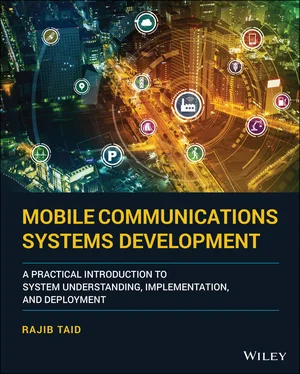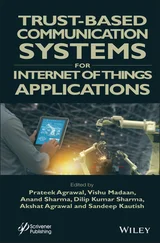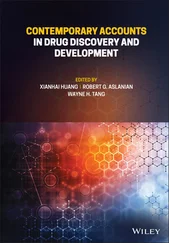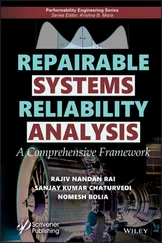Rajib Taid

This edition first published 2021
© 2021 John Wiley & Sons Ltd
All rights reserved. No part of this publication may be reproduced, stored in a retrieval system, or transmitted, in any form or by any means, electronic, mechanical, photocopying, recording, or otherwise, except as permitted by law. Advice on how to obtain permission to reuse material from this title is available at http://www.wiley.com/go/permissions.
The right of Rajib Taid to be identified as the author of this work has been asserted in accordance with law.
Registered Offices John Wiley & Sons, Inc., 111 River Street, Hoboken, NJ 07030, USA John Wiley & Sons Ltd, The Atrium, Southern Gate, Chichester, West Sussex, PO19 8SQ, UK
Editorial Office The Atrium, Southern Gate, Chichester, West Sussex, PO19 8SQ, UK
For details of our global editorial offices, customer services, and more information about Wiley products, visit us at www.wiley.com.
Wiley also publishes its books in a variety of electronic formats and by print‐on‐demand. Some content that appears in standard print versions of this book may not be available in other formats.
Limit of Liability/Disclaimer of Warranty While the publisher and authors have used their best efforts in preparing this work, they make no representations or warranties with respect to the accuracy or completeness of the contents of this work and specifically disclaim all warranties, including without limitation any implied warranties of merchantability or fitness for a particular purpose. No warranty may be created or extended by sales representatives, written sales materials or promotional statements for this work. The fact that an organization, website, or product is referred to in this work as a citation and/or potential source of further information does not mean that the publisher and authors endorse the information or services the organization, website, or product may provide or recommendations it may make. This work is sold with the understanding that the publisher is not engaged in rendering professional services. The advice and strategies contained herein may not be suitable for your situation. You should consult with a specialist where appropriate. Further, readers should be aware that websites listed in this work may have changed or disappeared between when this work was written and when it is read. Neither the publisher nor authors shall be liable for any loss of profit or any other commercial damages, including but not limited to special, incidental, consequential, or other damages.
Library of Congress Cataloging‐in‐Publication Data applied for
ISBN 9781119778684 (Hardback)
Cover Design: Wiley
Cover Image: © Metamorworks/Shutterstock, Cnythzl/iStock/Getty Images
All the opinions, except the granted copyrighted materials being used, expressed in this book are author’s own, from personal experiences and does not represent either from the past or present employer.
Designations used by companies to distinguish their products are often claimed as trademarks. All brand names and product names used in this book are trade names, service marks, trademarks or registered trademarks of their respective owners. The publisher is not associated with any product or vendor mentioned in this book.
Rajib Taid graduated with a Bachelor of Computer Science and Engineering degree from Jorhat Engineering College, Assam, India. He began his career as an Engineer (Telemetry) at GAIL, a public‐sector entity. Rajib worked there for four years in the area of design and development of application software systems for a gas pipeline. Then, he joined a Gurgaon (Haryana, India)‐based communication software services major as well as product development MNC, Aricent Technologies (www.aricent.com), formerly known as Hughes Software Systems, where he started working as a software developer in the area of mobile communications. He worked there for 12 years, both as an individual contributor and in a lead role, primarily developing software in Radio Access Network, and Core Network domains. The author also visited Australia, the USA and the UAE for onsite assignments. He hails from the Jorhat district of Assam, India.
In 2013, Rajib left the mobile telecommunication software development domain and joined BCPL, a public‐sector entity at Dibrugarh, close to his hometown in Assam. Currently, the author specializes in IT and enterprise business information systems management.
Rajib Taid is also a member of the Department Management Committee, as an industry expert, for the Department of Computer Science and Engineering in the Dibrugarh University Institute of Engineering and Technology, Assam, India.
Today, we are using at least one smartphone for our day‐to‐day voice, data communications, online gaming, and transaction services. To enable these services, we are also aware of the different mobile communications technologies that are available around us today, such as GSM, GPRS/EDGE, 3G, 4G, and 5G being the latest communication buzzword. If you are wondering and, sometimes, scouring the web regarding how a mobile communications system is designed, developed, tested, and deployed, then this book is for you! This is an introductory jump‐start, foundational, and comprehensive book offering several key concepts encompassing the various practical aspects for the design and development of a mobile communications system and its various entities/elements based on the GSM, GPRS, UMTS (3G), LTE (4G), and 5G technologies. Note that this book is not about the developments of Mobile Application (apps) software that is intended and developed for a specific purpose/requirement.
The content of this book is specially tailored for the rookie computer science or electronics and communications engineering graduate engineer who has just passed out of college, or even for a lesser experienced person looking for an opportunity to work in the mobile telecommunications space through re‐skilling. It starts with the various mobile communications network architectures, identification of a particular network element, the concerned 3GPP standard specifications, various protocols/stacks, as well as the development platforms such as UNIX, and multicore computing. In this book, the reader will also find the troubleshooting of any issue arising out of post‐deployment and operation of a mobile communication network element. This book also introduces the “multicore processor” computing platform that is available around us and is the current buzzword in different areas of technologies, be it the desktop or mobile handset. Mobile telecommunications system development using an embedded system platform is also briefly covered.
A mobile communication network works and communicates based on the standard technical specifications related to a particular mobile communication technology such as the GSM, GPRS, UMTS, LTE, and 5G system. Also, mobile communication standard technical specifications are large in number and can be bewildering to a new learner. Reading and its implementation, through computer code, of the contents of a GSM/GPRS/UMTS/LTE/5G technical specification requires a substantial amount of effort, especially the Layer 1 and Layer 2 protocols. From a technical specification, one would come to know what to and when to transmit or receive information. But what is not available in the 3GPP technical specifications is the how to implement part as it is implementation dependent. This book was written keeping these facts in mind, so that students can learn the practical, real‐world mobile telecommunications domain subject areas and equip themselves while in college, before starting a career in the relevant domains. To make the contents easier to understand, necessary figures, tables, and sample codes are provided to illustrate the underlying concepts. The illustrative figures and concepts are sometimes general in nature, i.e. applicable for GSM/GPRS or UMTS/LTE/5G system, or all of them, and sometimes a straight copy from the concerned 3GPP technical specification with due permissions.
Читать дальше













